Term 3 Unit 2 | History | 6th Social Science - The Post-Mauryan India | 6th Social Science : History : Term 3 Unit 2 : The Post-Mauryan India
Chapter: 6th Social Science : History : Term 3 Unit 2 : The Post-Mauryan India
The Post-Mauryan India
Unit 2
The
Post-Mauryan India
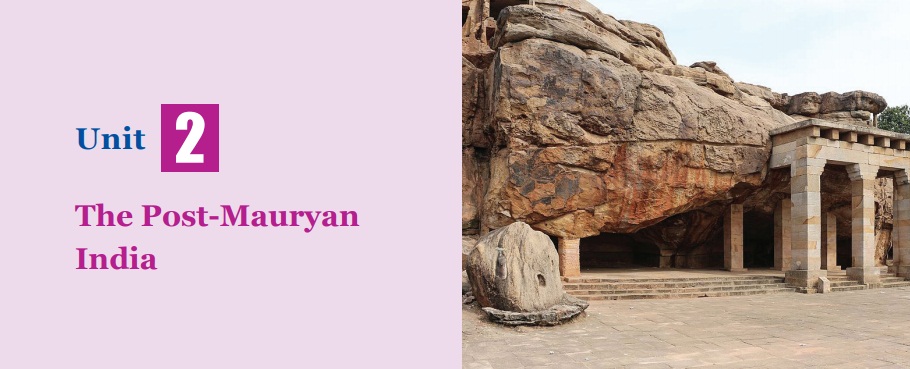
Learning Objectives
• To acquire knowledge of the
history of dynasties and kingdoms that emerged after the breakup of the Mauryan
Empire
• To gain an understanding of
the polity, society, economy, and culture of various kingdoms that were
established in the south, north and north-west of India
• To become familiar with their
contributions to early medieval India
Introduction
The break-up of Mauryan Empire resulted in the
invasions of Sakas, Scythians, Parthians, Indo-Greeks or Bactrian Greeks and
Kushanas from the north-west. In the south, Satavahanas became independent
after Asoka’s death. There were Sungas and Kanvas in the north before the
emergence of Gupta dynasty. Chedis (Kalinga) declared their independence.
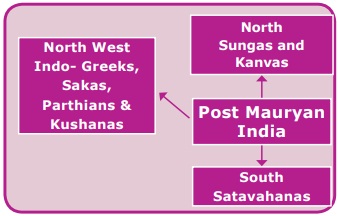
It has to be noted
here that, though Magadha ceased to be the premier state of India, it continued
to be a great centre of Buddhist culture.
Sources
Archaeological Sources
Inscriptions
* Ayodhya Inscription of Dana Deva
* Persepolis, Nakshi Rustam Inscriptions
* Moga(Taxila copper plate)
* Junagadh/Girnar Inscription
* Nasik
Prasasti
* Inscription of Darius I
Coins
* Coins of Satavahanas
* Coins of Kadphises II
* Roman coins
Literary
Sources
* Puranas
* Gargi Samhita
* Harshacharita of Banabhatta
* Mahabhasya of Patanjali
* Brihastkatha of Gunadhya
* Madhyamika Sutra of Nagarjuna
* Buddhacharita of Asvaghosha
* Malavikagnimitra of Kalidasa
Foreign
Notice
* Hiuen Tsang, the Chinese Buddhist monk and traveler
The Sungas and Kanvas in the North
The Sungas
The last Mauryan emperor, Brihadratha, was
assassinated by his own general, Pushyamitra Sunga, who established his Sunga
dynasty in Magadha. Pushyamitra made Pataliputra as his capital.
Pushyamitra’s kingdom extended westward to include
Ujjain and Vidisha. He successfully repulsed the invasion of Bactria king, Menander.
But Menander managed to keep Kabul and Sindh.
Pushyamitra
thwarted an attack from the Kalinga king Kharavela. He also conquered Vidarba.
He was a staunch follower of Vedic religion. He performed two Asvamedha yagnas (horse sacrifices) to assert his imperial
authority.
During the Sunga period, stone was
replaced by wood in the railings and the gateways of the Buddhist stupas as
seen in Bharhut and Sanchi.
Pushyamitra was
succeeded by his son Agnimitra. This Agnimitra is said to be the hero of
Kalidasa’s Malavikagnimitra. The drama also refers to the victory of
Vasumitra, Agnimitra’s son, over the Greeks on the banks of the Sindhu river.
The weak successors
of Sungas constantly faced threats from the Indo-Bactrians and Indo-Parthians.
The Sunga dynasty lasted for about one hundred years. The last Sunga king was
Devabhuti. He was killed by his own minister Vasudeva Kanva. Vasudeva
established the rule of Kanva dynasty in Magadha.
Importance of
the Sunga Period
The Sungas played
an important role in defending the Gangetic Valley from the encroachments of
the Bactrian Greeks. Pushyamitra, and then his successors, revived Vedic
religious practices and promoted Vaishnavism. Sanskrit gradually gained
ascendancy and became the court language.
Patanjali, the second grammarian in
Sanskrit, was patronized by Pushyamitra.
Though Pushyamitra
persecuted Buddhists, during his reign the Buddhist monuments at Bharhut and
Sanchi were renovated and further improved. The Great Stupa of Sanchi and the
railings, which enclose it, belong to the Sunga period.
King
Kharavela of Kalinga was a contemporary of the Sungas. We get information about
Kharavela from the Hathigumba Inscription.
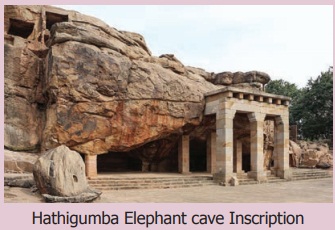
The
Kanvas
The Kanva dynasty
produced four kings and their rule lasted only for 45 years.The history of
Magadha after the fall of the Kanvas is devoid of any significance until the
emergence of the Gupta dynasty.
The Kanva
rulers were
* Vasudeva
* Bhumi Mitra
* Narayana
* Susarman
The last Kanva
ruler Susarman was assassinated by his powerful feudatory chief of Andhra named
Simuka, who laid the foundation of the Satavahana dynasty.
Satavahanas
in the South
The Kushanas in the
north and the Satavahanas (Andhras) in the south flourished for about 300 years
and 450 years, respectively. Simuka, the founder of the Satavahana dynasty, is
said to have ruled for twenty-three years. His successor was his brother
Krishna. The latter and his nephew Satakarni ruled for ten years each,
establishing an empire, holding control over a vast area stretching from
Rajasthan in the northwest to Andhra in the southeast and from Gujarat in the
west to Kalinga in the east. Satakarni is said to have performed two horse
sacrifices (Asvamedha yagna) , indicative of his imperial position.
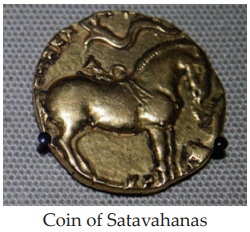
GautamiputraSatakarni
was the greatest ruler of the family. In the Nasik prashasti, published
by his mother GautamiBalasri, GautamiputraSatakarni is described as the
destroyer of Sakas, Yavanas (Greeks) and Pahlavas (Parthians). The extent of
the empire is also mentioned in the record. Their domain included Maharashtra,
north Konkan, Berar, Gujarat, Kathiawar and Malwa. His ship coins are
suggestive of Andhras’ skill in seafaring and their naval power. The Bogor
inscriptions suggest that South India played an important role in the process
of early state formation in Southeast Asia.
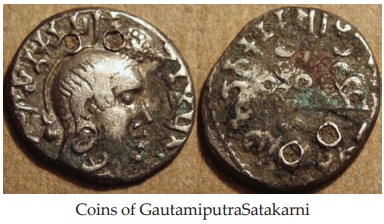
Contributions of Satavahanas
Literature
The Satavahana king Hala was himself a great
scholar of Sanskrit. The Kantara school of Sanskrit flourished in the Deccan in
second century B.C. Hala is famous as the author of Sattasai (Saptasati), 700
stanzas in Prakrit.
Art and
Architecture
The Satavahana rulers were great builders. They
began constructing Buddhist Stupas in
Amaravati.
The world-famous life-size statues
of Buddha at Bamyan valley on the mountains of the erstwhile northwestern
frontiers of ancient India (currently in central Afghanistan and recently
destroyed by the Talibans), were carved out of the solid rocks by the dedicated
artists of the Gandhara School of Art during the post-Mauryan period.
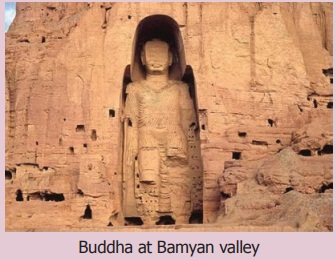
A bronze statue of
the standing Buddha discovered in Oc-Eo (an archaeological site in Vietnam)
resembles the Amaravati style. The later Satavahana kings issued lead or bronze
coins depicting ships with two masts. A stone seal discovered in NakhonPathom
in Thailand has the same design.
Gandhara, Madhura,
Amaravati, Bodh Gaya, Sanchi and Bharhut were known for splendid monuments and
art. The Mathura School of Sculpture produced images and life-size statues of
the Buddhist, Brahmanical and Jain deities.
Indo-Greeks,
Indo-Parthians, Sakas and Kushanas
Indo-Greeks
and Indo-Parthians
After the conquest
of north-western India and the Punjab region, Alexander the Great left the
conquered territories under provincial governors. Two of its eastern satrapies,
Bactria and Parthia, revolted under their Greek Governors and declared their
independence. The satrapy of Bactria became independent under the leadership of
Diodotus I and Parthia under Arsaces.
After the decline
of the Mauryan empire, the Greek rulers of Bactria and Parthia started
encroaching into the northwestern border lands of India. The Bactrian and
Parthian settlers gradually inter-married and inter-mixed with the indigenous
population. This facilitated the establishment of Indo-Greek and Indo-Parthian
colonies along the north-western part of India.
Rulers of Indo Greeks
Demetrius I – He was the son of
Greco- Bactrian ruler Euthydemus.
He was king of Macedonia from 294
to288 BC (BCE). Numismatic evidence proves that Demetrius issued bi-lingual
square coins with Greek on the obverse and Kharosthi on the reverse. Scholars
are not able to decide which of the three,named Demetrius, was the initiator of
theYavana era, commencing from second Demetrius Menander century BC (BCE) in
India.
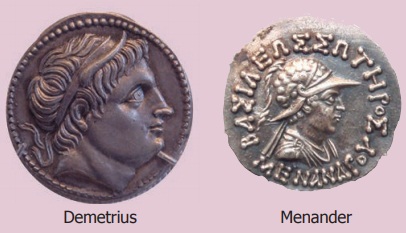
Menander– He was one of the best known Indo-Greek kings. He is said to have ruled a large kingdom in the north-west of the country. His coins were found over an extensive area ranging from Kabul valley and Indus river to western Uttar Pradesh. MilindaPanha, a Buddhist text, is a discourse between Bactrian king Milinda and the learned Buddhist scholar Nagasena. This Milinda is identified with Menander. Menander is believed to have become a Buddhist and promoted Buddhism.
Contributions
of
Indo-Greeks
Coinage: Indo-Greek
rulers introduced a die system and produced properly shaped coins with
inscription, symbols and engraved fi gures on them. Indians learnt this art
from them.
Sculpture: The Gandhara School of Indian Art is heavily indebted to Greek
infl uence. The Greeks were good cave builders. The Mahayana Buddhists learnt
the art of carving out caves from them and became skilled in rock-cut
archicture.
Sakas
The Indo-Greek rule
in India was ended by the Sakas. Sakas as nomads came in huge number and spread
all over northern and western India. The Sakas were against the tribe of Turki
nomads. Sakas were Scythians, nomadic ancient Iranians, and known as Sakas in
Sanskrit.
Saka rule was
founded by Maos or Mogain in the Gandhara region and his capital was ‘Sirkap’.
His name is mentioned in Mora inscription. His coins bear images of Buddha and
Siva.
Rulers of Indo-Parthians (Pahlavas)
Indo-Parthians came after the
Indo-Greeks and the Indo-Scythians who were, in turn, defeated by the Kushanas
in the second half of the first century AD (CE). Indo-Parthian kingdom or
Gondopharid dynasty was founded by Gondophernes. The domain of Indo-Parthians
comprised Kabul and Gandhara. The name of Gondophernes is associated with the
Christian apostle St.Thomas. According to Christian tradition, St.Thomas
visited the court of Gondophernes and converted him to Christianity.
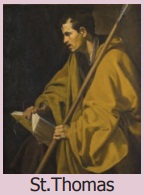
St.Thomas
Rudradaman was the
most important and famous king of Sakas. His Junagadh/Girnar inscription was
the first inscription in chaste Sanskrit. In India, the Sakas were assimilated
into Indian society. They began to adopt Indian names and practise Indian
religious beliefs.
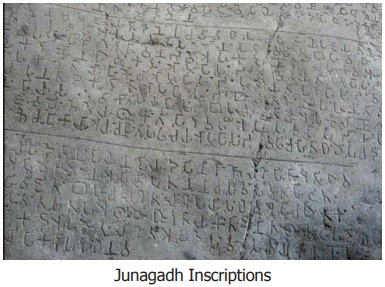
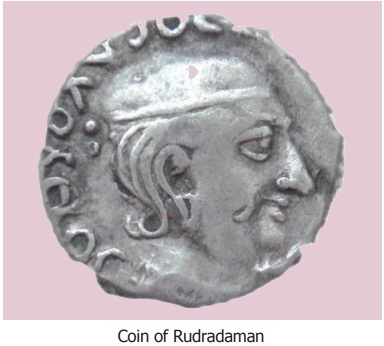
The Sakas appointed kshatrapas or satraps as
provincial governors to administer their territories.
Kushanas
The Kushanas formed a section of the yueh-chi
tribes, who inhabited north-western China in the remote past. In the first century BC(BCE), the yueh-chi tribes were
composed of five major sections, of which the Kushanas attained political
ascendancy over others.
By the beginning of
Christian era, all the yueh-chi tribes had acknowledged the supremacy of the
Kushanas; they had shed their nomadic habits and settled down in the Bactrian
and Parthian lands, adjacent to the north-western border of India.
The Kushanas
overran Bactria and Parthia and gradually established themselves in northern
India. Their concentration was mostly in the Punjab, Rajaputana and Kathiawar.
Kushana rulers were Buddhists. Takshashila and Mathura continued to be great
centres of Buddhist learning, attracting students from China and western Asia.
The Kushana
Kings
Kanishka
Kanishka was the
greatest of all the Kushana emperors. He assumed the sovereignty in 78 AD and
proclaimed his rule by the foundation of a new era, which later became Saka
era.
The Kushana capital
initially was Kabul. Later, it was shifted to Peshavar or Purushpura.
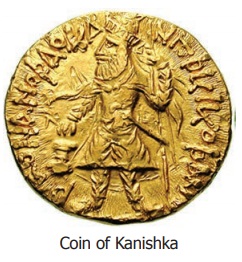
Kadphises
I
He was the first famous military and political
leader of the Kushanas. He overthrew the Indo-Greek and Indo-Parthian rulers
and established himself as a sovereign ruler of Bactria. He extended his power
in Kabul, Gandhara and upto the Indus.
Kadphises
II
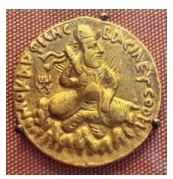
He maintained friendly relationship with the
emperors of China and Rome and encouraged trade and commerce with the foreign
countries. Some of his coins contained the inscribed figures of Lord Siva and
his imperial titles were inscribed in the Kharosthi language.
Conquests
Kanishka conquered
and annexed Kashmir. He waged a successful war against Magadha. He also waged a
war against a ruler of Parthia to maintain safety and integrity in his vast
empire on the western and south-western border. After the conquest of Kashmir
and Gandhara, he turned his attention towards China. He defeated the Chinese
general Pan-Chiang and safeguarded the northern borders of India from Chinese
intrusion.
His empire extended
from Kashmir down to Benaras, and the Vindhya mountain in the south. It
included Kashgar, Yarkhand touching the borders of Persia and Parthia.
Religious
Policy
Kanishka was an
ardent Buddhist. Kanishka’s empire was a Buddhist empire. Kanishka adopted
Buddhism under the influence of Asvaghosha, a celebrated monk from Pataliputra.
Though a great warrior and an em pire-builder, Kanishka was as equal as the
exponent and champion of Mahayanism.
Kanishka made Buddhism
as the state religion and built many stupas and monasteries in Mathura, Taxila
and many other parts of his kingdom. He sent Buddhist missionaries to Tibet,
China and many countries of Central Asia for the propagation of Buddha’s
gospel.
He organised the
fourth Buddhist Council at Kundalavana near Srinagar to sort out the
differences between the various schools of Buddhism. It was only in this
council that Buddhism was split into Hinayanism and Mahayanism.
Art and
Literature
Kanishka was a
great patron of art and literature. His court was adorned with a number of
Buddhist saints and scholars, like Asvaghosha, Vasumitra and Nagarjuna.
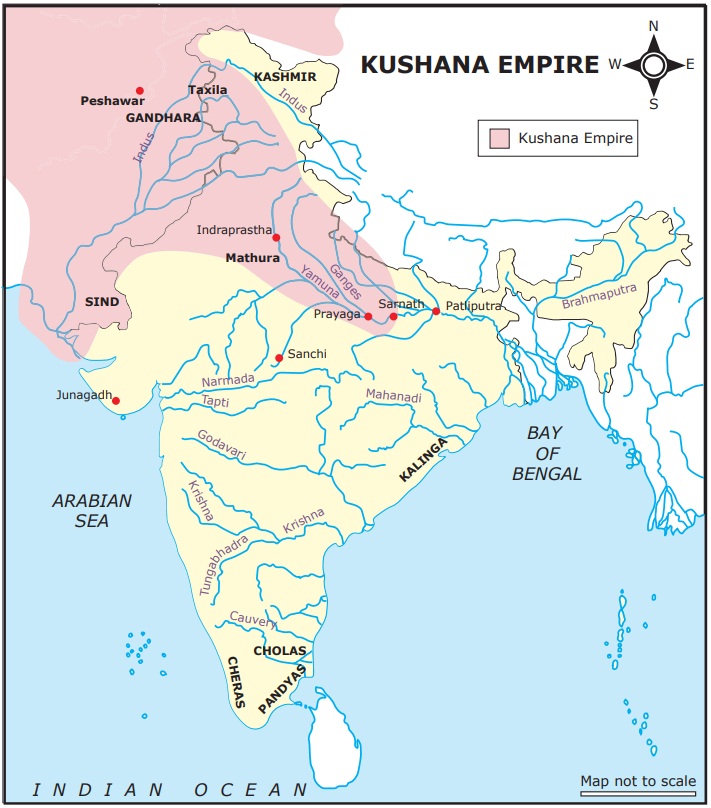
Asvaghosha was the celebrated author
of the first Sanskrit play, Buddhacharita.
He founded the town
of Kanishkapura in Kashmir and furnished the capital of Purushapura with
magnificent public buildings.
The Gandhara
School of Art flourished during his time. The most favourite subject of the
Gandhara
artists was the carving of sculptures of Buddha.
Buddhist learning
and culture was taken to China and Mongolia from Takshashila. The great Asiatic
culture mingled with Indian Buddhist culture during the Kushana’s time.
Kanishka’s
successors were weak and incompetent. Kushana empire rapidly disintegrated into
number of small principalities.
Elsewhere
Kushana Empire corresponded with the
last days of the Roman Republic, when Julius Caesar was alive. It is said that
Kushana Emperor sent a great embassy to Augustus Caesar.
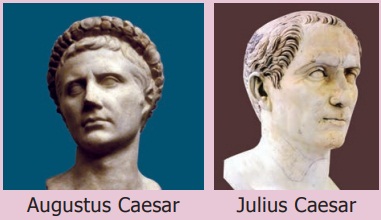
Summary
* The break-up of Mauryan empire resulted in the
invasions of Sakas, Scythians, Parthians, Indo-Greeks and Kushanas from the
north-west.
* The last Mauryan emperor, Brihadratha, was
assassinated by his own general, Pushyamitra Sunga, who established Sunga
dynasty in Magadha.
* The history of Magadha after the fall of the
Kanvas is devoid of any significance until the emergence of the Gupta dynasty.
* The Kushanas in the north and the Satavahanas
(Andhras) in the south flourished for about 300 years and 450 years,
respectively.
* Rudradaman was the most important and famous
king of Sakas.
* The best known of the Kushanas was Kanishka who
was an ardent follower of Mahayana form of Buddhism. Gandhara Art developed
during this period.
GLOSSARY
1. repulsed driven
back by force விரட்டியடிக்கப்பட்டது
2. thwarted prevent
from accomplishing something முறியடிக்கப்பட்டது
3. encroachments intrusion
oaperson’s territory, rights etc, ஆக்கிரமிப்புகள்
4. renovated Restored(somethingold,especiallya
building) to a good state of repair
புதுப்பிக்கப்பட்டது
5. assimilate absorb
(information, ideas or culture) fully ஒன்றிப்போதல்
6. ardent enthusiastic
or passionate தீவிர
7. magnificent impressively
beautiful அற்புதமான
Related Topics